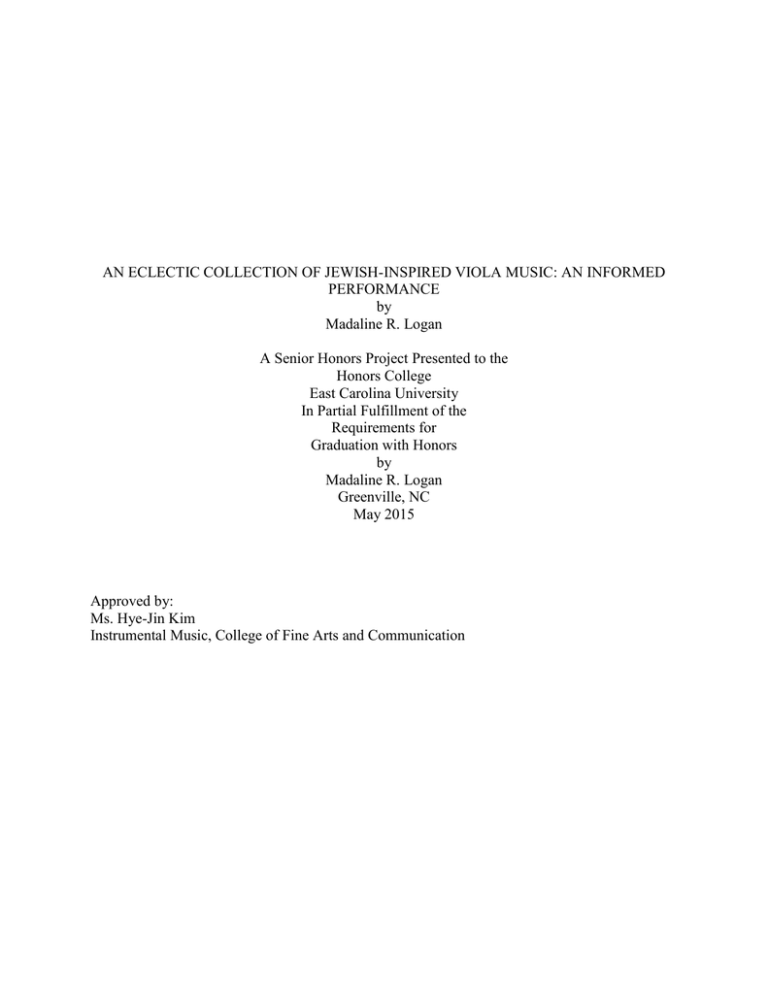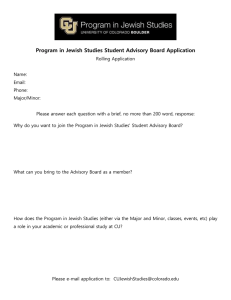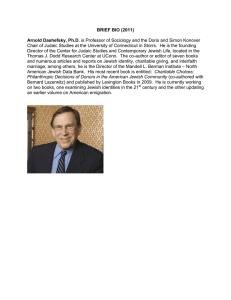AN ECLECTIC COLLECTION OF JEWISH-INSPIRED VIOLA MUSIC: AN INFORMED PERFORMANCE by
advertisement

AN ECLECTIC COLLECTION OF JEWISH-INSPIRED VIOLA MUSIC: AN INFORMED PERFORMANCE by Madaline R. Logan A Senior Honors Project Presented to the Honors College East Carolina University In Partial Fulfillment of the Requirements for Graduation with Honors by Madaline R. Logan Greenville, NC May 2015 Approved by: Ms. Hye-Jin Kim Instrumental Music, College of Fine Arts and Communication Music performance in a recital setting involves the integration of numerous elements and tools rigorously studied and refined over a substantial number of years. These components include: the physical playing of the instrument, rhythm, melodies, harmonies, dynamics, musical characters, composers, music history, styles of music, and a variety of others. A musician must assimilate musical components learned from dedicated teachers into a cohesive, performable entity, especially when preparing for a recital. For this research project and subsequent performance, I combined all the various elements learned in my years of studying music (that include the above listed elements), selected the theme of Jewish-inspired viola music for my recital program, learned the actual notes of the pieces, studied Jewish music in general, and researched the specific composers’ various backgrounds and how their own experiences affected and shaped their music. I then put my part playing the viola together with the pianist’s part through the collaborative effort of playing chamber music, in order to produce a unified, performable program. The various aspects of this program’s music and the process of synchronizing the parts culminated in the performance of the music in the form of a lecture recital that provided the audience with details about the specific pieces and their composers in order to give them a context in which to better understand the music. Program EAST CAROLINA UNIVERSITY School of Music and the Honors College present An Eclectic Collection of Jewish-Inspired Viola Music: An Informed Performance Hebrew Melodies, op. 9 I. Sostenuto II. Grave III. Andante cantabile Joseph Joachim (1831-1937) Suite for Viola IV. Molto Vivo Ernest Bloch (1880-1959) ~brief intermission~ performed by Madaline Logan, viola Chahagir, op. 56a Alan Hovhaness (1911-2000) Suite Hebraique I. Rapsodie II. Processional III. Affirmation Ernest Bloch (1880-1959) in senior recital with Justin Sturz, piano Sunday, March 22nd, 2015 A. J. Fletcher Music Center 5:00 p.m. This recital is presented in partial fulfillment of the requirements for the Bachelor of Music in Music Therapy Note s for SHP Recital/Presentation Good evening - title - describe “informed performance” and its significance to both performer and audience Joseph Joachim -***error in program: not really 106, only 76 (died in 1907 instead of 1937) - parents of Hungarian Jewish ancestry, was 7th of 8 kids - prodigy on violin, playing in Eck concerto with teacher at ripe old age of 8 - went to Mendelssohn’s conservatory in 1843 - was also good friends with Brahms and the Schumanns - debuted in Leipzig in concert with Clara Schumann and Mendelssohn - noble music and not filled with flashy tricks: known for his simplicity, subtle use of rubato - piece composed in 1854 - subtitled "From Impressions of Byron's Poems" - mostly dark in color and beautifully exploits the viola's ability to express sadness and lamentation - Sostenuto and Grave, are in the minor and filled with melancholy and pathos - Andante cantabile, is mostly pastoral in character although the middle section is quicker and more dramatic - Lord Byron published book of lyrics with musical settings set to Jewish tunes by Isaac Nathan, called Hebrew Melodies, in 1815 - Byron’s poems later published as book of poems (about 30 of them) - these provided title for Joachim’s musical impressions, but exact connection between specific poems and the movements are uncertain - poems appear to be based on Old Testament stories (various kings (Saul and Belshazzar), Jeptha, Job, the tribes of Israel, Moses and the 10 commandments from the perspective of the people on the ground – On Jordan’s Banks) - has Romantic style, influence of Brahms and Schumann heard throughout with rhythm and texture - intellectually Jewish-inspired because of subtitle and influence of Byron’s literary work - not overtly Jewish, but still thematic evidence of Jewish influence (4ths and 5ths in movements 1 and 2, and occasional augmented 2nd in 2nd and 3rd movements) - ABA form for all movements Bloch -born in Geneva, Swiss-descent, Jewish ancestry, also lived in US (moved there in 1916) – lived in Ohio and San Francisco - had a diverse musical training that included advanced violin training, study of eurhythmics with Émile Jacques-Dalcroze - did not pioneer any new style in music but spoke with a distinctive voice into which he could assimilate folk influences, 12-tone technique, and even coloristic quarter tones. - around 1910, he began writing music with specifically Jewish aspects in subject matter, reflected by orientalisms in the melodies -- often derived from Jewish worship chants and folk music - some of the best-known compositions of this series are the violin work Baal-Shem, an Israel Symphony, and Schelomo, a tone poem that also is one of the great cello concertos - had “Jewish cycle” but much of music influenced by Middle Eastern music - not necessarily influenced by liturgical Jewish music and writing music based on specific melodies as he was captivated by the soul behind the Jewish music and expressing that intense emotion Suite for Viola - composed in 1919, while he was living in NY, trying to find his identity, possibly as a Jewish composer - not overtly Jewish, but in notes about 4th movement, Bloch himself specifically refers to the hints of Jewishness in the 4th music - additionally, says this is probably the most cheerful thing he ever wrote: quite upbeat, since both A sections (since piece is in ABA form) contain large amounts of various accents and staccato markings - also, in G. Schirmer edition, the Star of David with the initials EB is interwoven into it as a mark of the composer - instead, leaves listener with faint impressions of Jewish music in tonality and harmony interwoven throughout - this piece is more introspective rather than containing emotional outbursts like those that characterize the Jewish Cycle - also wonderfully depicts the “Bloch rhythm” - The Scotch-snap rhythm and its variants is so pervasive that it has come to be known as the ‘Bloch rhythm’. (shorter stressed note, then longer note, so sixteenth then dotted eighth rather than what we usually find) Alan Hovhaness - unique 20th century composer who composed a wide variety of music influenced by a wide variety of ethnic music, including Renaissance polyphony, South Indian, Japanese, Kurdish, and Armenian music - dove into these music types wholeheartedly, both in aesthetic appeal and depth of ethnic character equal to the music he strove to assimilate into his own - also influenced by Armenian minimalist composer-priest Komitas, and tried to say as much as possible in as few notes as possible: evident in Chahagir - born in Boston suburb of Somerville, Mass. in 1911: father Armenian descent (Adana, now in Turkey) and mother (Madeleine Scott) of Scottish descent - highly influenced by Armenian and Kurdish singers and Eastern melodies in his 20s, and became organist of Armenian church in 1940 - Jews influenced Armenian church near its beginnings, thus music is not overtly Jewishinfluenced, but Armenian music and Jewish music share many similar flavors since Armenian church part of Orthodox church in Middle East - composed Chahagir in 1944, at beginning of what is known as his Armenian period (music based on modes and influenced by Armenian melodies) - almost all of his music has deeply spiritual ties, exotic and philosophical as well - modal harmony evident - loved mountains, and music contains openness evident from looking across world from a mountain - piece evident of both of last points: minimal amount of notes, and wide-open feel - through-composed, but develops theme - a processional that sounds as if it begins far away and ends in a present/arrival type of feel - Jewish-influenced based: augmented 2nds - Chahagir comes from Hebrew word meaning “torch bearer” (which is one of the four pillars of the Armenian Orthodox Church) Suite Hebraique - composed in 1951, while Bloch was living in Oregon - dedicated to the members of Chicago’s Covenant Club because they had sponsored a weeklong Blochfest not too long prior to his composing it - thought to have been originally combined with 2 other movements, afterward published as Meditation and Processional - both 2nd and 3rd movements are processionals, but because of the emphatic ending that moves out of the modal setting in which it started and finishes in A major - superbly depicts Bloch’s desire to capture the soul behind Jewish music and tug on the emotions, especially with the Rapsodie - repressed passion strikes as one hears the Rapsodie especially - Jewish elements also include the shofar calls – instrument played at the beginnings of feasts or festivals, or to make an important announcement - perfect fourth interval that sounds kind of impending or a warning - also wonderfully depicts the “Bloch rhythm” and showcases emotional side of his music - mention personal connection with shoulder, and how began piece freshman year and wanted to return to it and come full circle as triumph over shoulder injury



